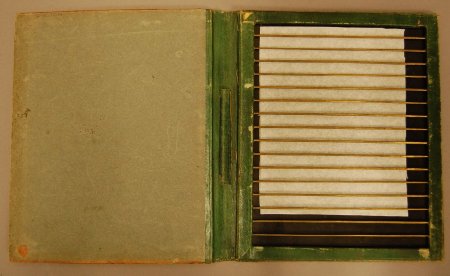Object ID:
2002.33.1a-c
Title:
Noctograph
Description:
2002.22.1a - Noctograph - writing frame is trimmed in green leather with black cloth tape on the back; sixteen (16) horizontal flattened-brass rods guide handwriting; frame is bound "book-like" in green paper-covered boards with a green leather spine; front cover has an accordion-style pocket for storing paper and a black-enameled tinplate backing plate; green leather stylus holder tube stitched to inner hinge. Frame, measuring 10 1/8 x 8 3/8 in., was used with a stylus, instead of pencil or pen; carbon paper was inserted between two sheets of writing paper that were placed beneath the writing frame and on top of the separate metal plate. 2002.33.1b - Paperbound booklet labeled "Semi-Carbonic Paper"; contains a few sheets of thick paper (may have protected carbon paper) and several tissue-like sheets of writing paper; two loose pieces of carbon paper are folded and inserted at the back; booklet measures 10 1/4 x 8 1/4 in. 2002.33.1c - Paperbound booklet containing sheets of tissue-like paper; measures 9 5/8 x 8 in.; first 4 sheets contain a letter written to (or from?) Jacob Barker in New York, dated 1811; "Ezekiel Web[ster?] M[orton?]" is written on verso of front cover.
Date:
ca. 1810
Made by:
[unknown]
Place of Origin:
Great Britain
Provenance:
Vendor identified Jacob Barker (1779-1871) as a New York merchant, lawyer, and financier. Ralph Wedgwood, an English inventor credited with inventing carbon paper, was issued a patent for "An Apparatus for Producing Duplicates of Writings" in 1806. The device, as described in the patent, is similar to this accession which is identified by the vendor as an original Prescott's Noctograph. William Hickling Prescott (1796-1859), a historian, was visually impaired and invented his noctograph for writing. The caption "Prescott's noctograph" appears beneath an illustration of the writing device included in the vendor's correspondence.
Credit Line:
Museum Purchase
